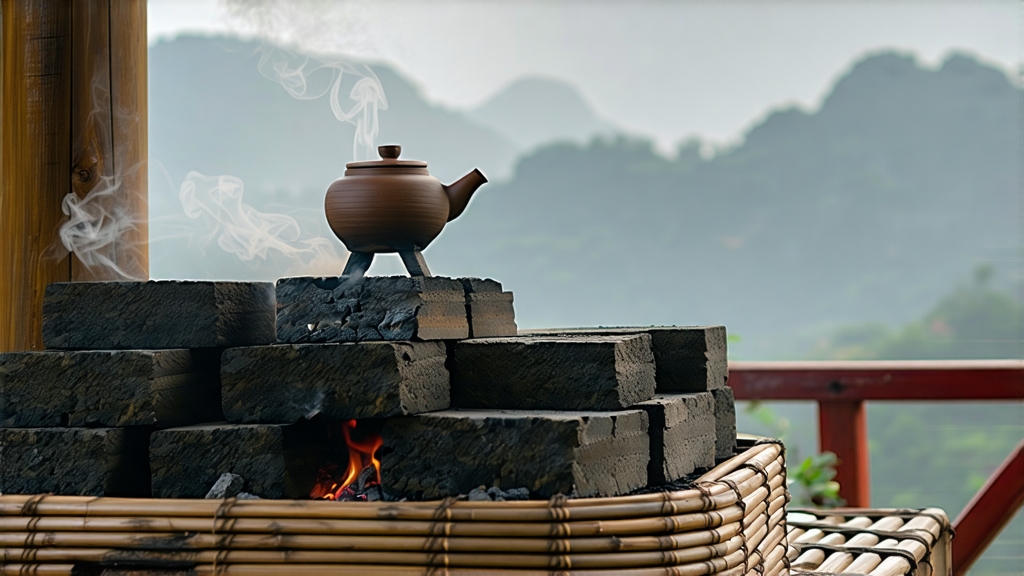
Tucked away in the humid, karst-studded borderlands of Guangxi Province, Liupao dark tea has spent four centuries perfecting the art of quiet transformation. While Pu-erh hogs the limelight, Liupao has remained the insider’s secret—an earthy, betel-nut scented brew once carried by porters along the Tea-Horse Road’s southern spur, now ready for the global stage. This article walks international drinkers through the complete Liupao experience: its origin myth, micro-terroirs, craft that borders on alchemy, and the subtle ritual that coaxes its signature “Song smoke & honey” cup.
-
From War Horses to Tea Baskets: A 400-Year Timeline
The name “Liupao” literally means “six fortresses,” a nod to the six stockaded villages that in 1585 first pooled surplus maocha to pay imperial horse taxes. The pressed tea traveled down the Liu River to Wuzhou port, where Dutch traders nicknamed it “black dragon leaf.” By the Qing dynasty it had become a TCM staple—dispensed for dampness and digestive woes in southern China’s sweltering summers. The 20th century saw Liupao fade as railways replaced river caravans, but a 2006 resurgence, fueled by aged-tea collectors, earned it National Geographic Indication status and a new generation of boutique producers. -
One Leaf, Three Styles
Liupao is not a single recipe but a family of three core shapes, each dictating aging speed and flavor arc.- Basket Liupao (sānɡ lán): 35–50 kg of lightly steamed leaf rammed into woven bamboo cylinders, still the workhorse of Guangxi humidity.
- Brick Liupao: hydraulic-pressed 250 g–1 kg rectangles favored by urban collectors for tidy cellaring.
- Loose “San Cha”: the pre-1950s style, sun-dried and piled in pine sheds, now prized for its wilder microflora and camphor finish.
-
Terroir: Where Caves Replace Cellars
The Liupao GI zone sits at 23–24 °N, 200–500 m elevation, wrapped in fog from the Dayao Mountains. The soil is lateritic red loam rich in kaolin, which releases aluminum ions that soften astringency during fermentation. The region’s 1,800 mm annual rainfall and 78 % average humidity create a natural “wet piling” climate, but the signature microbe, Aspergillus liupaoensis, is actually cave-dwelling. Producers finish aging in limestone caverns that maintain 25 °C and 85 % RH year-round—nature’s own thermostat. -
Craft: The Double Steam & Basket Cure
Unlike Pu-erh’s wodui, Liupao undergoes a “double steam” process. After spring plucking (one bud & three leaves), the maocha is withered 4 h, pan-killed at 160 °C for eight minutes, then rolled until 60 % cell rupture. First steam (100 °C, 20 s) softens the leaf for 7-day pile fermentation in pine-lined chambers; internal temperature climbs to 55 °C, triggering the coveted “golden flowers” (Eurotium cristatum). A second steam (lighter, 10 s) readies the leaf for ramming into bamboo baskets lined with wild taro leaves. The baskets are lidded, lashed with rattan, and transferred to caves for 180–300 days of “basket cure,” where anaerobic microbes metabolize taro alkaloids, gifting the tea its signature betel-nut note. -
Aging Grammar: How Time Translates into Flavor
Liupao ages on a logarithmic curve. Years 1–3: dominant fungal notes—cedar, camphor, wet bark. Years 4–7: betel nut and dark honey emerge, liquor turns chestnut-red. Years 8–15: pine smoke softens, replaced by dried longan, sandalwood, and a cooling menthol finish. Beyond 15 years the tea enters “medicinal octave”: prune, black cardamom, and a lingering quartz-mineral sweetness that echoes Wuyi yancha. -
Brewing: The Clay & Charcoal Dialogue
Western brewers often over-handle Liupao, mistaking its dark leaf for toughness